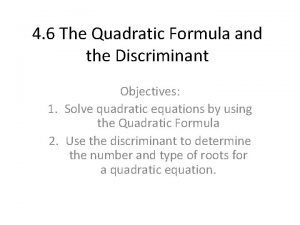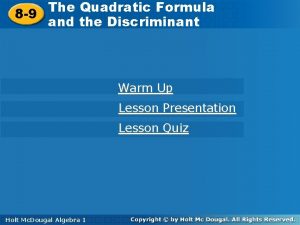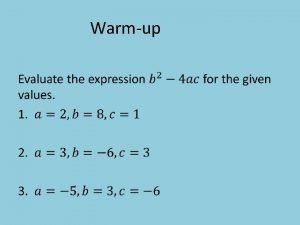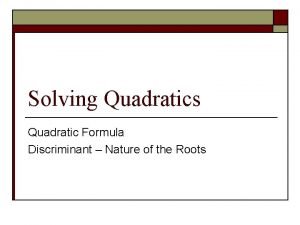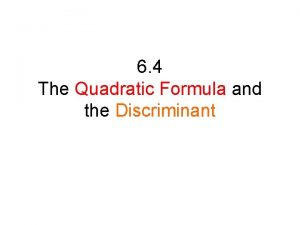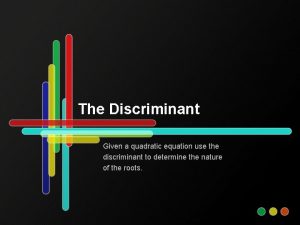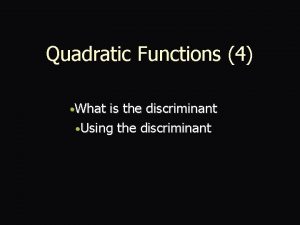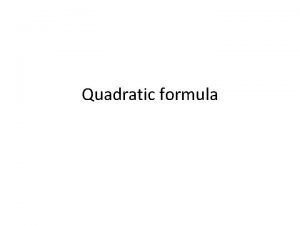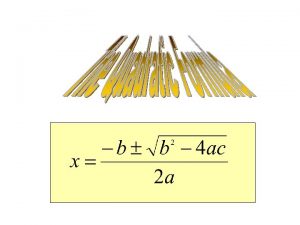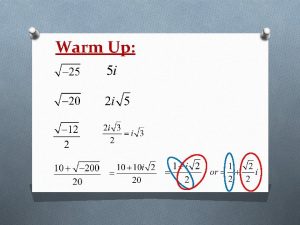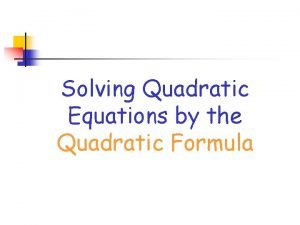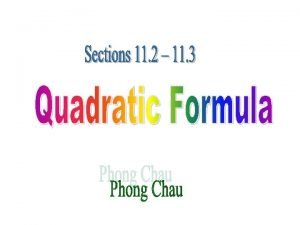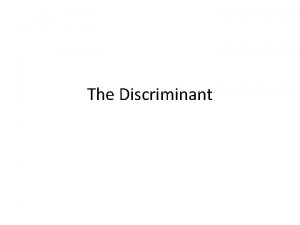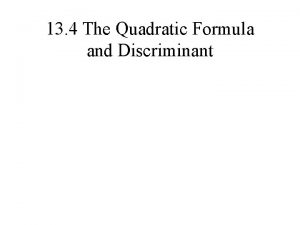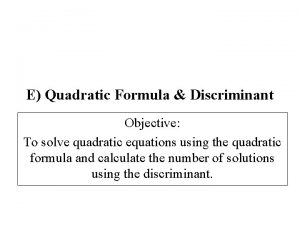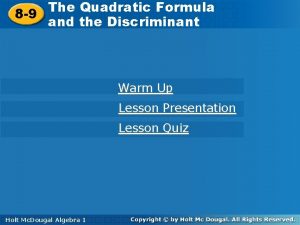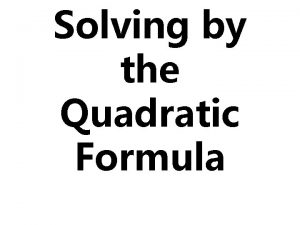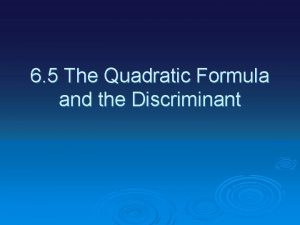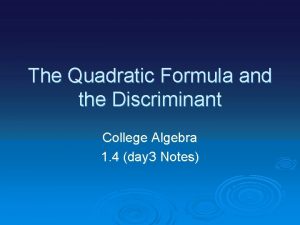Quadratic Formula and the Discriminant How many solutions












- Slides: 12

Quadratic Formula and the Discriminant How many solutions does your quadratic have?

Discriminant= expression under the radical = b 2 -4 ac The value of the discriminant determines how many solutions (or roots / zeros) the quadratic will have. If b 2 -4 ac is positive, then 2 solutions If b 2 -4 ac is 0, then 1 solution If b 2 -4 ac is negative, then no solution

Use the discriminant to determine how many zerors the quadratic will have Example 1. x 2 – 2 x + 1 = 0 b 2 – 4 ac (102) – 4(1)(25) 100 – 100 = 0 One real solution (1 zero / 1 root) Plug values into formula simplify Classify solution Remember if we had used the full quadratic formula, we found just one solution because +0 and -0 do not alter the value

Solve the following three quadratics using only the quadratic formula. Show your work. Example 2. 3 x 2 + 4 x + 8 = 0 b 2 – 4 ac (42) – 4(3)(8) 16 – 96 = -80 No solutions Plug values into formula simplify Classify solution Remember if we had used the full quadratic formula, we have had no solution because you can’t square root a negative number

Solve the following three quadratics using only the quadratic formula. Show your work. Example 3. 2 x 2 + 7 x - 4 = 0 b 2 – 4 ac (72) – 4(2)(-4) 49 + 32 = 81 Two solutions Plug values into formula simplify Classify solution Remember if we had used the full quadratic formula, we found 2 solutions because +9 and -9 would alter the value as you simplify

When we solve a quadratic, we are finding where the parabola intercepts the x-axis. What is the difference between these three graphs? Which of these three graphs belongs to a quadratic with a positive discriminant? Which belongs to a quadratic with a negative discriminant? Which graph has a discriminant equal to zero?

Practice State whether the discriminant of each quadratic is positive, negative, or equal to zero. Discrim. = 0 Negative Discrim. Positive Discrim. Because the parabola has 2 x- parabola has 2 xhas only 1 x-intercept parabola has no xintercepts (solution) intercepts

Practice: Without solving, determine the number of real solutions for each quadratic equation. 1. x 2 + 7 x + 33 = 8 – 3 x 3. 2 x 2 + 10 x = x 2 + 4 x - 3 x 2 + 10 x + 25 = 0 (102) – 4(1)(25) 0 One real solution 2. 7 x 2 + 2 x + 5 = 0 (22) – 4(7)(5) 4 – 140 -136 No real solutions x 2 + 6 x + 3 = 0 (62) – 4(1)(3) 24 Two real solutions 4. 4 x 2 + 9 = -4 x 4 x 2 + 4 x + 9 = 0 (42) – 4(4)(9) 16 – 144 = -128 No real solutions

What if you are solving by factoring Use the discriminant to help • If discriminant (b 2 -4 ac) is NEGATIVE • there are NO SOLUTIONS • it CAN’T BE FACTORED • If discriminant (b 2 -4 ac) is 0 • there is ONE SOLUTION • it CAN FACTOR • If discriminant (b 2 -4 ac) is positive • there are TWO SOLUTIONS • but it can only be factored if the discriminant is a perfect square! • the other solutions would have radical answers

Use the discriminant to determine if a trinomial can be factored -2 x 2+3 x-6 b 2 -4 ac 32 - 4(-2)(-6) 9 – 48 -39 Negative discriminant means No Real Solutions! Can’t be factored

Use the discriminant to determine if a trinomial can be factored x 2 -5 x+4 b 2 -4 ac (-5)2 - 4(1)(4) 25 – 16 9 POSITIVE perfect square discriminant means Two Solutions, It CAN be factored

A quadratic trinomial can only factor if the discriminant IS A PERFECT SQUARE!!!
 The quadratic formula and the discriminant
The quadratic formula and the discriminant Quadratic formula and discriminant
Quadratic formula and discriminant 8-9 the quadratic formula and the discriminant
8-9 the quadratic formula and the discriminant Discriminant for quadratic equation
Discriminant for quadratic equation Quadratic formula discriminant
Quadratic formula discriminant How to derive the quadratic formula from ax2+bx+c=0
How to derive the quadratic formula from ax2+bx+c=0 Find the discriminant of the quadratic expression
Find the discriminant of the quadratic expression Quadratic function discriminant
Quadratic function discriminant Diskriminantas formule
Diskriminantas formule How to know how many solutions a quadratic equation has
How to know how many solutions a quadratic equation has Types of discriminant solutions
Types of discriminant solutions Site:slidetodoc.com
Site:slidetodoc.com Discriminant examples
Discriminant examples

